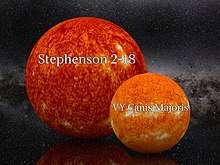Stephenson 2-18
Stephenson 2-18, also known as RSGC2-18, is a red supergiant (RSG) star within the open cluster Stephenson 2 located around 6,000 parsecs away in the constellation of Scutum.[2] It is currently among the largest known stars, if not the largest, and one of most luminous cool supergiants, with an estimated radius around 2,200 times that of the Sun (R☉), which corresponds to a volume around 10 billion times bigger than the Sun. If placed at the center of the Solar System, its photosphere would engulf the orbit of Saturn.
 Dense starfield around the red supergiant star St2-18 (brightest star in the image) as seen from the 2MASS astronomical survey. The picture was published in 2003. Credit: Université de Strasbourg/CNRS | |
| Observation data Epoch J2000 Equinox J2000 | |
|---|---|
| Constellation | Scutum |
| Right ascension | 18h 39m 02.3709s[1] |
| Declination | −06° 05′ 10.5357″[1] |
| Characteristics | |
| Evolutionary stage | Red supergiant |
| Astrometry | |
| Proper motion (μ) | RA: −3.045[1] mas/yr Dec.: −5.950[1] mas/yr |
| Parallax (π) | −0.0081 ± 0.3120[1] mas |
| Distance | 19,560[2] ly (6,000[2] pc) |
| Details | |
| Radius | 2,150[3] R☉ |
| Luminosity | 90,000[4] - 440,000[3] L☉ |
| Temperature | 3,200[3] K |
| Other designations | |
| Database references | |
| SIMBAD | data |
Observation history
The open cluster Stephenson 2 was discovered by American astronomer Stephenson in 1990 in the data obtained by a deep infrared survey.[5][6]
Physical properties

Stephenson 2-18 is classified as an extremely large and high luminosity cool supergiant star. In 2012, a calculation of the bolometric luminosity by fitting the Spectral Energy Distribution (SED) give the star a luminosity of 440,000 L☉, with an effective temperature of 3,200 K, which corresponds to a very large but unusually high radius of 2,150 R☉ (1.50×109 km; 10.0 au; 930,000,000 mi), which is considerably larger and more luminous than expected for any red supergiant and extreme.[3] An alternate calculation gives a much lower luminosity of 90,000 L☉ and correspondingly lower radius values.[4]
References
- Brown, A. G. A.; et al. (Gaia collaboration) (August 2018). "Gaia Data Release 2: Summary of the contents and survey properties". Astronomy & Astrophysics. 616. A1. arXiv:1804.09365. Bibcode:2018A&A...616A...1G. doi:10.1051/0004-6361/201833051. Gaia DR2 record for this source at VizieR.
- Davies, B.; Figer, D. F.; Kudritzki, R. P.; MacKenty, J.; Najarro, F.; Herrero, A. (2007). "A Massive Cluster of Red Supergiants at the Base of the Scutum‐Crux Arm". The Astrophysical Journal. 671 (1): 781–801. arXiv:0708.0821. Bibcode:2007ApJ...671..781D. doi:10.1086/522224.
- Fok, Thomas K. T; Nakashima, Jun-ichi; Yung, Bosco H. K; Hsia, Chih-Hao; Deguchi, Shuji (2012). "Maser Observations of Westerlund 1 and Comprehensive Considerations on Maser Properties of Red Supergiants Associated with Massive Clusters". The Astrophysical Journal. 760 (1): 65. arXiv:1209.6427. Bibcode:2012ApJ...760...65F. doi:10.1088/0004-637X/760/1/65.
- Deguchi, Shuji; Nakashima, Jun-Ichi; Zhang, Yong; Chong, Selina S. N.; Koike, Kazutaka; Kwok, Sun (2010). "SiO and H2O Maser Observations of Red Supergiants in Star Clusters Embedded in the Galactic Disk". Publications of the Astronomical Society of Japan. 62 (2): 391–407. arXiv:1002.2492. Bibcode:2010PASJ...62..391D. doi:10.1093/pasj/62.2.391.
- Davies, B.; Figer, D. F.; Kudritzki, R. P.; MacKenty, J.; Najarro, F.; Herrero, A. (2007). "A Massive Cluster of Red Supergiants at the Base of the Scutum‐Crux Arm". The Astrophysical Journal. 671 (1): 781–801. arXiv:0708.0821. Bibcode:2007ApJ...671..781D. doi:10.1086/522224.
- Stephenson, C. B. (1990). "A possible new and very remote galactic cluster". The Astronomical Journal. 99: 1867. Bibcode:1990AJ.....99.1867S. doi:10.1086/115464.